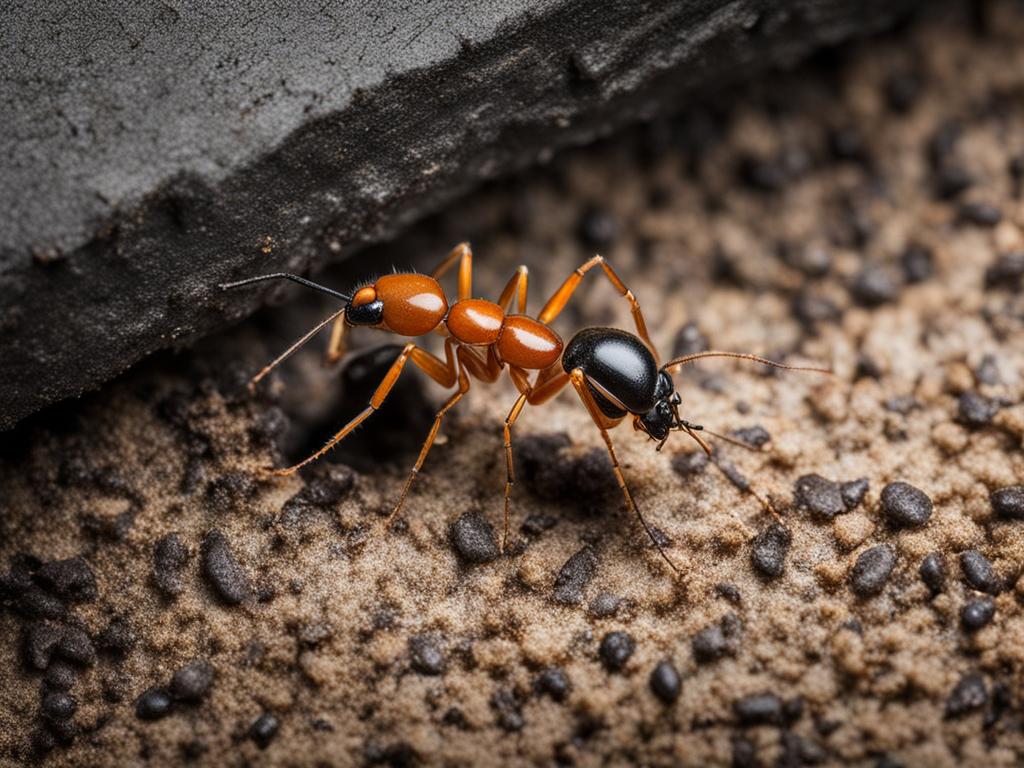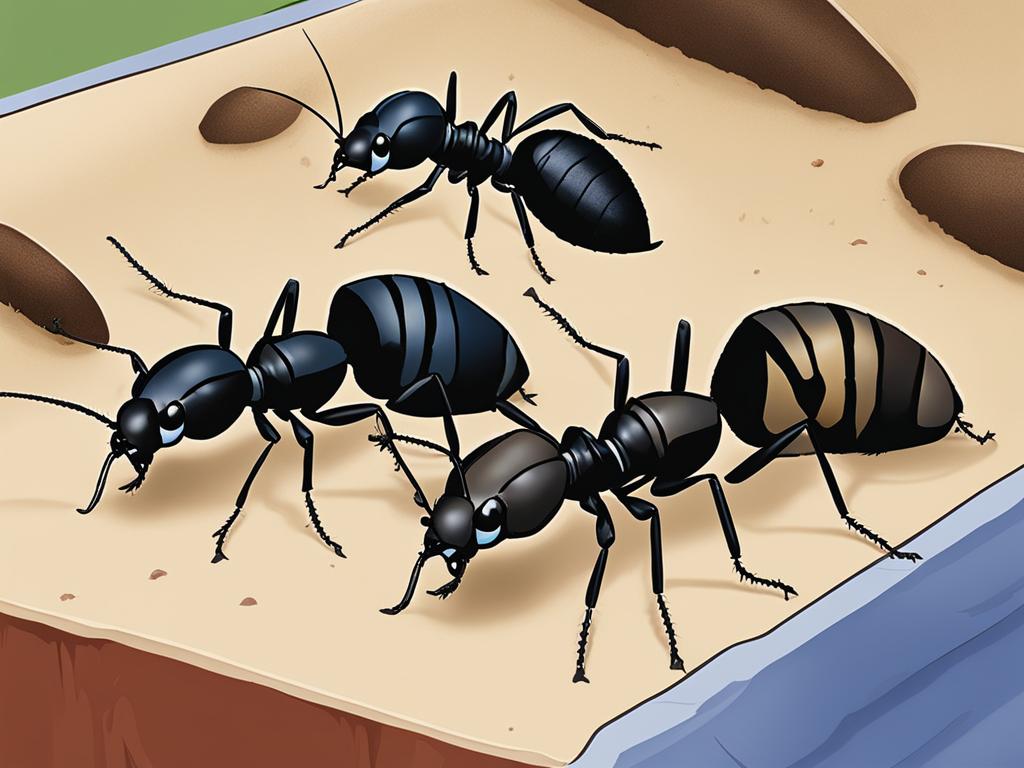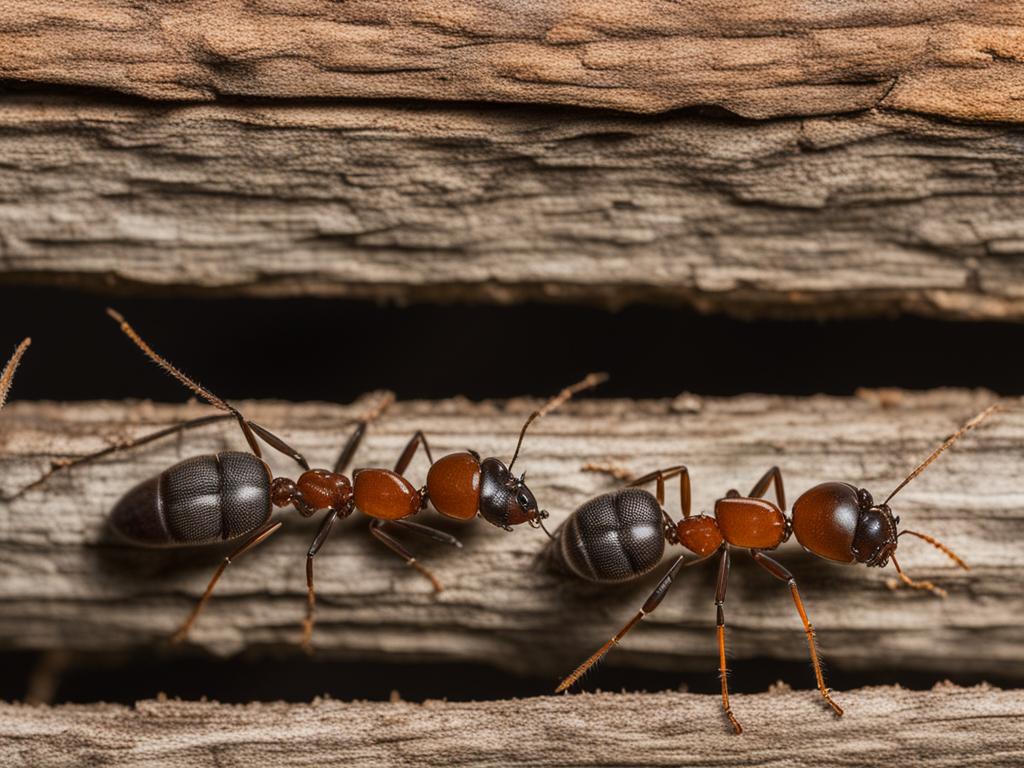When it comes to dealing with ants on your property, it’s important to know the differences between species. Two common types of ants that you may encounter are pavement ants and carpenter ants. While they may look similar at first glance, their behaviors, nesting preferences, and potential damage they can cause are distinct.
Understanding the characteristics of pavement ants and carpenter ants can help you identify and deal with infestations effectively. So, let’s take a closer look at the key differences between these two ant species.
Key Takeaways:
- Pavement ants prefer nesting in rocks and pavement cracks, while carpenter ants prefer moist wood.
- Carpenter ants are larger in size compared to pavement ants.
- Carpenter ants can cause significant damage to structures over time, while pavement ants are more of a nuisance.
- Identifying the physical characteristics and signs of infestation for each species can help determine the appropriate treatment method.
- Seeking professional assistance is recommended for effective removal and prevention of both pavement ants and carpenter ants.
Identifying Pavement Ants
Pavement ants are small in size, measuring about 2.5 to 4 mm in length. They are dark brown to black in color with parallel lines on their head and thorax. Worker ants are approximately 1/8 to 1/16 of an inch long and dark brown or black. Winged pavement ants are larger than workers. They tend to establish their colonies and forage beneath sidewalks, cement slabs, and large rocks.
Infestations can be identified by the presence of small soil particles and sand mounds in structures, along with debris from excavated nests. Pavement ants primarily feed on sugar, nectar, fruits, dead insects, and small seeds.

| Physical Characteristics of Pavement Ants | Signs of Pavement Ant Infestation |
|---|---|
|
|
Identifying Carpenter Ants
When it comes to identifying carpenter ants, there are several physical characteristics and signs of infestation to look out for. Carpenter ants are larger in size compared to pavement ants, measuring between 1/2 to 5/8 of an inch in length. These ants can come in different colors, including black, brown, red, orange, and yellowish brown.
One distinctive feature of carpenter ants is their rounded thorax and heart-shaped head. They also have a hair circle around the anus. Additionally, the forewings of queen carpenter ants and reproductive males are larger than the hind wings. It is important to note that carpenter ants are often mistaken for winged termites, but their wings are pale brown or translucent, setting them apart from termites.

Carpenter ants prefer to nest in moist and decaying wood, which can cause significant damage to structures over time. Signs of carpenter ant infestation include the presence of sawdust-like frass or wood shavings near wooden structures, particularly near window frames, doorways, and areas with high moisture. You may also notice rustling or crunching sounds coming from within the walls.
“Carpenter ants can cause extensive damage to wooden structures if left untreated. Identifying and addressing an infestation early on is crucial to prevent further destruction.”
If you suspect a carpenter ant infestation in your property, it is recommended to seek professional assistance for effective removal and prevention strategies. Carpenter ants can be particularly challenging to eliminate due to their ability to establish satellite nests, making it important to address the root of the problem.
Comparison of Physical Characteristics
| Carpenter Ants | Pavement Ants | |
|---|---|---|
| Size | Larger: 1/2 to 5/8 inch | Smaller: 2.5 to 4 mm |
| Color | Various colors, including black, brown, red, orange, and yellowish brown | Dark brown to black |
| Wings | Pale brown or translucent wings | No wings (workers), larger wings (reproductive individuals) |
| Nesting | In moist and decaying wood | In rocks, pavement cracks, and hard surfaces |
| Damage | Significant structural damage over time | More of an inconvenience |
Conclusion
In conclusion, understanding the differences between pavement ants and carpenter ants is crucial for effective pest control.
Pavement ants primarily nest in rocks and pavement cracks, while carpenter ants prefer moist wood. Carpenter ants are larger in size and can cause structural damage to your property, while pavement ants are more of an inconvenience, with their presence being more bothersome than damaging.
By identifying the physical characteristics and signs of infestation for each species, you can determine the appropriate treatment method. If you suspect an infestation of either species, it is highly recommended to seek professional assistance for effective removal and prevention. Professional pest control services have the expertise and tools to handle ant infestations safely and efficiently.
Don’t let ants take over your home or property. Take action and ensure a pest-free environment for you and your family!
FAQ
What are the key differences between pavement ants and carpenter ants?
Pavement ants prefer to nest in rocks, pavement cracks, and other hard surfaces, while carpenter ants prefer moist and decaying wood. Carpenter ants are larger in size and can cause structural damage, while pavement ants are more of an inconvenience.
How can I identify pavement ants?
Pavement ants are small in size, measuring about 2.5 to 4 mm in length. They are dark brown to black in color with parallel lines on their head and thorax. They tend to establish their colonies and forage beneath sidewalks, cement slabs, and large rocks. Signs of infestation include the presence of small soil particles, sand mounds, and debris from excavated nests.
How can I identify carpenter ants?
Carpenter ants are larger in size, measuring between 1/2 to 5/8 of an inch in length. They can come in different colors, including black, brown, red, orange, and yellowish brown. They have a rounded thorax, heart-shaped head, and a hair circle around the anus. Carpenter ants prefer to nest in moist and decaying wood.
What are the signs of pavement ant infestation?
Signs of pavement ant infestation include small soil particles, sand mounds, and debris from excavated nests in structures. Pavement ants primarily feed on sugar, nectar, fruits, dead insects, and small seeds.
What are the signs of carpenter ant infestation?
Signs of carpenter ant infestation include the presence of sawdust-like material (frass), smooth and clean galleries inside wood structures, and rustling sounds within the walls. Carpenter ants primarily feed on dead insects, termites, budworm larvae, nectar, and aphid honeydew.
